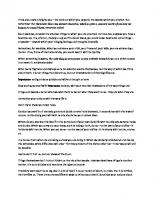The Space-Distribution of the Photo-Electrons Ejected by X-Rays
245 36 683KB
English Pages 5 Year 1927
Recommend Papers
File loading please wait...
Citation preview
t84
r4Pf YSICS: E. C. WA TSON6
PRO'C. W,. A. S.
of - 0.0256 being shifted far enough so that it no longer coincides with the corresponding component in the resonance source.4 * NATIONAL REsEARCH FZLLow. 'Phil. Mag., 47, 832. 2Zs. Phys., 31, 617. 3 von Keussler (Ann. Phys., 82, No. 6) had previously shown that with a wide line source (arc) the polarization became complete in 7900 gausses. 4 MacNair, these PROCEEDINGS, 13, 430, 1927.
THE SPACE-DISTRIBUTION OF THE PHOTO-ELECTRONS EJECTED BY X-RA YS By E. C. WATSON NORMAN BRIDGR LABORATORY OF PHYSICS, PASADENA, CALIFORNIA Read before the Academy April 26, 1927
The experiments of Wilson,' Auger,2 Bothe,3 Bubb,4 Loughridge5 and Kirchner6 by the C. T. R. Wilson cloud expansion-chamber method have shown that while the most probable direction of the photo-electron tracks in a gas traversed by X-rays is nearly the direction of the electric vector of the incident radiation, there is apparently a very considerable "spread" in the direction of the tracks. Magnetic spectra of the electrons ejected from very thin metallic films at various angles show similar effects.7 Theories to account for this apparent emission from the atom over a wide range of angles instead of in one definite direction have been given by Bubb,8 Bothe,9 Auger and Perrin,'0 Wentzell' and Beck,12 but none of them is satisfactory in explaining all the now known experimental facts. The purpose of this paper is to point out that nuclear scattering of the sort postulated by Rutherford with such brilliant success in the case of a-particles has not been sufficiently considered in this connection and that it probably will account for the whole effect. I. Experimental Facts.-The experiments bearing upon this question have been of two general types: (a) those which make use of unpolarized X-rays and study the distribution of electrons about tlhe direction of the X-ray beam (this we shall for convenience call the longitudinal distribution) and (b) those which use polarized X-rays and study the distribution about the direction of the electric vector in a plane perpendicular to the direction of the X-ray beam (this. we shall call the lateral distribution). It is necessary for the present paper and important, in general, that the present experimental situation be precisely stated and as this has nowhere been' done, the following brief summary is given:
PHYSICS. E. C. WATSON
VOL. 13, 1927
585
(1) The longitudinal distribution function has a pronounced maximum in a direction a little forward of perpendicular to the direction of the X-rays beam and falls to zero at approximately 900 either side of this maximum (this is agreed upon by all observers). (2) The lateral distribution function has a pronounced maximum in exactly the direction of the electric vector and does not fall to zero at 90° from this direction (this last difference between 1 and 2 has not hitherto
v< < 0'
![Imaging Light with Photoelectrons on the Nano-Femto Scale [1st ed.]
9783030528355, 9783030528362](https://ebin.pub/img/200x200/imaging-light-with-photoelectrons-on-the-nano-femto-scale-1st-ed-9783030528355-9783030528362.jpg)







![The History by Herodotus, History of the Peloponnesian War by Thucydides [1 ed.]
0852291639](https://ebin.pub/img/200x200/the-history-by-herodotus-history-of-the-peloponnesian-war-by-thucydides-1nbsped-0852291639.jpg)

